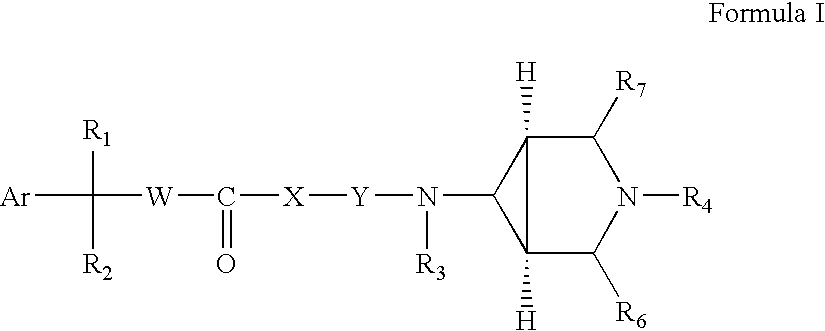3,6-Disubstituted azabicyclo hexane derivatives as muscarinic receptor antagonists
a technology of azabicyclohexane and derivatives, which is applied in the field of derivatives of 3, 6disubstituted azabicyclohexane, can solve the problems of clinical utility, difficult to assign specific functions to individual receptors, and little progress, and achieves high affinity for m3 receptors. , the effect of significant potency
- Summary
- Abstract
- Description
- Claims
- Application Information
AI Technical Summary
Benefits of technology
Problems solved by technology
Method used
Image
Examples
example 1
Preparation of (2S)-(1α, 5α, 6α)-6-N-[3-benzyl-3-azabicyclo[3.1.0]-hexyl]-2-[1R or 1S)-3-oxocyclohexyl]-2-hydroxy-2-phenylacetamide (Compound No.1)
Step-a: Synthesis of (2S, 5S)-2-tert-butyl-5-phenyl-1,3-dioxalan-4-one.
The compound was synthesized following the procedure described in J. Org. Chem., 2000; 65: 6283-6287, using S-(+)-Mandelic acid.
Step-b: Synthesis of (2S, 5S)-2-tert-butyl-5-[(1R or 1S)-3-oxocyclohexyl-5-phenyl-1,3-dioxolan-4-one.
[0066] Lithium diisopropylamide (6.9 mmol) was added to a solution of compound of step a (4.6 mmol) in tetrahydrofuran (40 ml) containing 2 ml of hexamethyl phosphoramide and precooled to −78° C. under nitrogen atmosphere. The reaction mixture was stirred for 1 hour at the same temperature, and then cyclohexenone (9.2 mmol) diluted with 3 ml of THF was added to the reaction mixture. The mixture was further stirred for 3 hours at the same temperature. The reaction mixture was diluted with ethyl acetate, washed with saturated ammonium chlo...
example 2
Preparation of (2S)-(1α, 5α, 6α)-6-N-[3-benzyl-3-azabicyclo[3.1.0]-hexyl]-2-[(1R or 1S, 3R or 3S-3-fluorocyclohexyl]-2-hydroxy-2-phenylacetamide (Compound No. 2)
Step-a: Synthesis of (2S)-tert-butyl-5-[(1R or 1S, 3R or 3S)-3-hydroxycyclohexyl]-5-phenyl-1,3-dioxalan-4-one.
[0069] The compound of Example 1, Step-b (1 mmol) was dissolved in methanol (5 ml) and cooled to 0° C. Sodium borohydride (2 mmol) was added in small lots and the reaction mixture was stirred at 0° C. for 1 hour. The solvent was removed under reduced pressure, the residue taken in ethyl acetate and washed with water. The organic layer was dried and the residue obtained after removal of solvents was used as such.
1HNMR (CDCl3): 7.66-7.28 (m, 5ArH), 5.40 (d, 1H), 3.6-3.4 (m, 1H), 2.04 (s, 4H), 1.21 (m, 5H), 0.92 (s, 9H)
IR (DCM): 1790 cm−1
Step-b: Synthesis of (2S, 5S)-2-tert-butyl-5-[(1R or 1S, 3R or 3S)-3-fluorocyclohexyl)-5-phenyl-1,3-dioxalan-4-one.
[0070] To the compound of step-a (1 mmol) in dichloromethane ...
example 3
Preparation of (2S)-(1α, 5α, 6α)-6-N-[3-benzyl-3-azabicyclo[3.1.0]-hexyl]-2-[(1R or 1S, 3R or 3S)-3-fluorocyclopentyl]-2-hydroxy-2-phenylacetamide (Compound No. 3)
Step-a: Synthesis of (2S, 5S)-2-tert-butyl-5-[(1R or 1S)-3-oxocyclopentyl]-5-phenyl-1,3-dioxolan-4-one.
The compound was synthesized following the procedure of Example 1, step-b, using 2-cyclopentenone instead of 2-cyclohexenone.
1HNMR (CDCl3): 7.70-7.26 (m, 5ArH), 5.40 (d, 1H), 2.88 (m, 1H), 2.37-1.05 (m, 6H), 0.90 (s, 9H).
IR (DCM): 1791 and 1746 cm−1
Step-b: Synthesis of (2S, 5S)-2-tert-butyl-5-[(1R or 1S, 3R or 3S)-3-hydroxycyclopentyl]-5-phenyl-1,3-dioxolan-4-one.
[0072] The compound was synthesized following the procedure of Example 2, step-a, using (2S, 5S)-2-tert-butyl-5-[(1R or 1S)-3-oxocyclopentyl]-5-phenyl-1,3-dioxolan-4-one instead of (2S, 5S)-2-tert-butyl-5-[(1R or 1S)-3-oxocyclohexyl]-5-phenyl-1,3-dioxolan-4-one.
1HNMR (CDCl3): 7.68-7.25 (m, 5ArH), 5.49 (d, 1H), 4.33-4.27 (m, 1H), 2.67-2.62 (m, 1H), 1.97...
PUM
| Property | Measurement | Unit |
|---|---|---|
| temperature | aaaaa | aaaaa |
| temperature | aaaaa | aaaaa |
| temperature | aaaaa | aaaaa |
Abstract
Description
Claims
Application Information
 Login to View More
Login to View More - R&D
- Intellectual Property
- Life Sciences
- Materials
- Tech Scout
- Unparalleled Data Quality
- Higher Quality Content
- 60% Fewer Hallucinations
Browse by: Latest US Patents, China's latest patents, Technical Efficacy Thesaurus, Application Domain, Technology Topic, Popular Technical Reports.
© 2025 PatSnap. All rights reserved.Legal|Privacy policy|Modern Slavery Act Transparency Statement|Sitemap|About US| Contact US: help@patsnap.com



